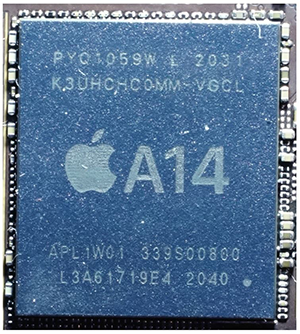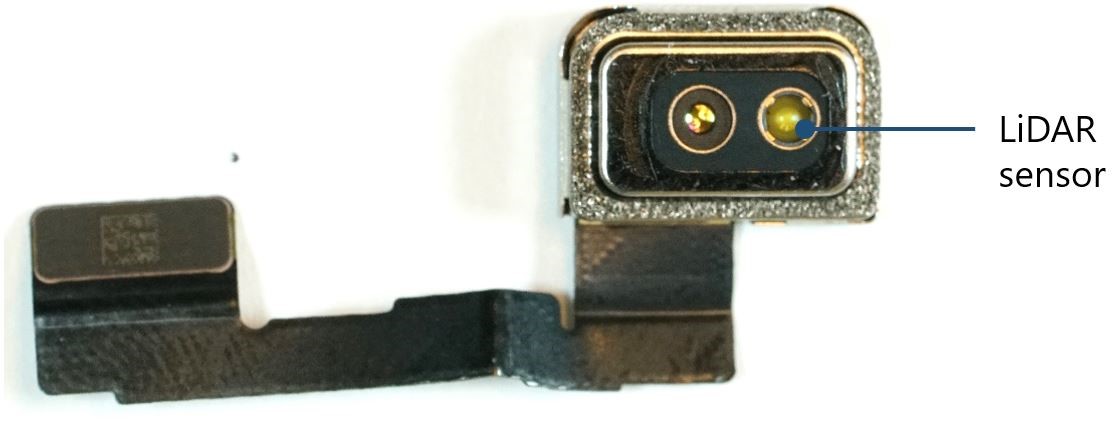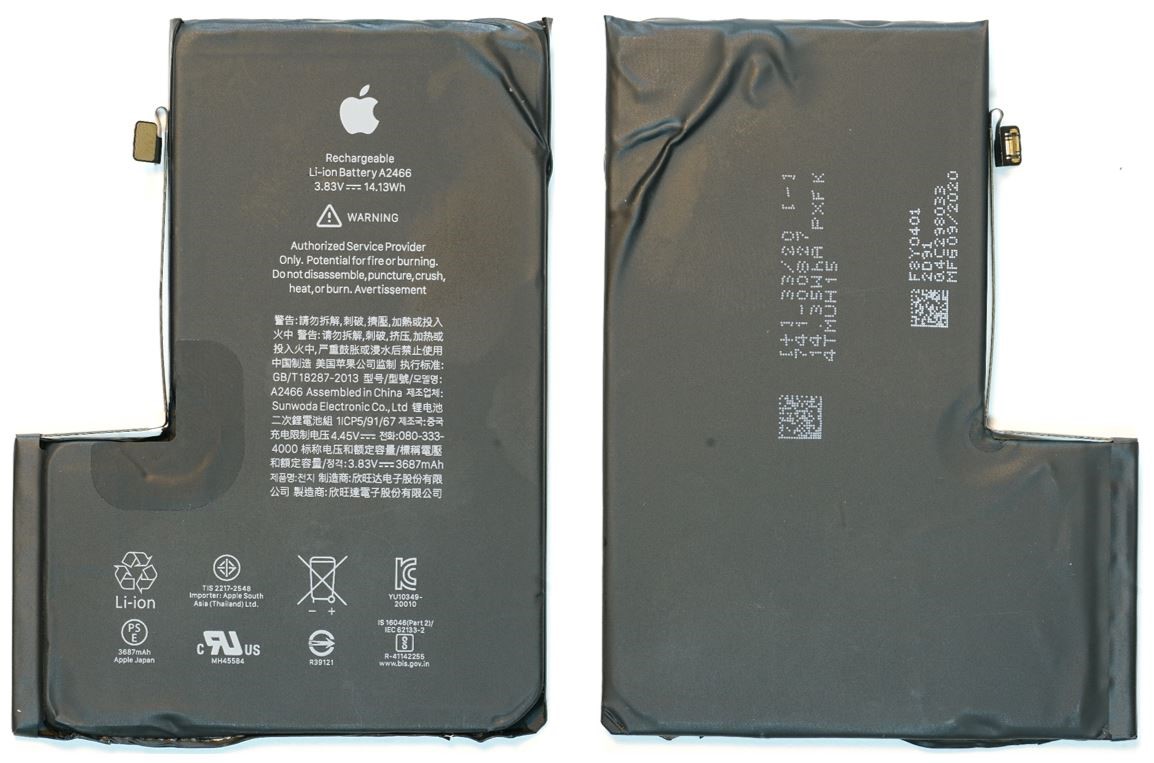On November 13th, 2020, Apple launched most the anticipated phone in its iPhone 12 series, the iPhone 12 Pro Max. The Pro Max version offers the largest display and the most features of all the phones in the iPhone 12 series.
In this teardown report of the iPhone 12 Pro Max (Model A2342, 128 GB, Graphite color), we will dissect Apple’s premium offering and see how it ranks in comparison to others in the lineup and its predecessors.
Design
The most noticeable design change on the 2020 iPhone lineup from the iPhone 11 series is the flattened sides. The iPhone 12 Pro Max also features a massive 6.7-inch OLED Super Retina XDR display compared to the 6.5-inch screen on iPhone 11 Pro Max, making iPhone 12 Pro Max the biggest phone Apple has ever made. In terms of dimensions, the iPhone 12
Pro Max is just slightly bigger than the iPhone 11 Pro Max achieved by taking advantage of the thinner flat bezels on the iPhone 12 lineup. In addition, the iPhone 12 Pro and iPhone 12 Pro Max feature a stainless-steel frame compared to the aluminum frame on the iPhone 12 and iPhone 12 mini.

Table 1: Comparison between iPhone 11 Pro series and iPhone 12 series

Figure 2: iPhone 12 Pro Max unboxed

Figure 3: iPhone 12 Pro Max – top and bottom view

Figure 4: iPhone 12 Pro Max – side views
Display
The display on iPhone 12 Pro Max supports 2778×1284 pixel resolution at 458 PPI compared to 2688×1242 pixel resolution at 458 PPI on the iPhone 11 Pro Max. The iPhone 12 lineup also features Ceramic Shield on the display which is a cover glass that has nano-ceramic crystals infused into the front-glass of the iPhone to improve its durability offering up to four times better drop protection as compared to its predecessors making it the toughest iPhone in the world.

Figure 5: Pixel layout of the OLED screen
Teardown
Like every iPhone since iPhone 5, the teardown of the device is initiated by removing the display screen. The adhesive underneath the screen of iPhone 12 Pro Max was softened upon heating. The screen is separated from rest of the body using a slack to reveal the logic boards and battery.
It was very surprising to see the difference in the stacked logic boards (PCBs) compared to iPhone 12 Pro and iPhone 12 PCBs we identified during our iPhone 12 Pro teardown. The design of the PCB stack is a same inverted ‘L’ shape, but wider and shorter compared to the PCB stack of the iPhone 12 Pro and iPhone 12. The PCB stack found in the Pro Max device seems to be smaller compared to the iPhone 12 Pro PCB stack and we believe this is to make more room for the higher capacity ‘L’ shaped battery used to power the larger display. This
also means that Apple had to populate the integrated circuits (ICs) on the PCB more densely. We observed that most of the ICs are common between the sibling PCB stacks but are placed differently to maintain PCB packing efficiency. The Taptic Engine (haptic feedback system) is also differently shaped and most likely includes a more powerful vibration motor. The rest of the major components such as camera modules (front and rear), bottom speaker module, mmWave antenna modules appear to be similar and similarly placed to the iPhone 12 Pro counterparts.

Figure 6: Removal of the iPhone 12 Pro Max screen

Figure 7: Removal of stacked logic boards, battery and other components
Apple A14 Bionic
The iPhone 12 Pro Max is powered by Apple’s A14 Bionic chip, which is a 5nm, 64-bit six-score CPU implementing ARMv8 ISA with two high performance cores called Firestorm and four energy-efficient cores called Icestorm. Apple is first in the industry to manufacture it with the 5nm process technology. It means lower power consumption for given amount of work and it is shared between all iPhones in the 12 series.
The A14 Bionic chip consists of 11.8B transistors which is about 40 percent more than the 8.5B transistors in the A13 Bionic chip. The A14 Bionic IC is a package-on-package (PoP) structure which comprises of the application processor IC package and a 6GB RAM package. The 6GB RAM is an upgrade from the last generation iPhones which had 4GB DRAM capacity.

Figure 8: A14 bionic chip
Cameras
The iPhone 12 Pro Max has the best camera system present in the 2020 iPhone lineup. The iPhone 12 Pro Max features a triple-back camera arrangement along with a LiDAR sensor. The iPhone 12 Pro Max back camera module includes ultra-wide, wide and telephoto cameras. The ultra-wide camera is a f/2.4 aperture which provides a 120 degree field of view aperture similar to that on the iPhone 12 lineup and iPhone 11 lineup.
The telephoto camera features a f/2.2 aperture compared to the f/2.0 aperture on the iPhone 12 Pro, iPhone 11 Pro, and iPhone 11 Pro Max, enabling the iPhone 12 Pro Max an 2.5x optical zoom as opposed to 2x optical zoom. This allows the iPhone Pro Max 5x to have a total 5x optical zoom range and up to 12x digital zoom compared to 4x optical zoom range and up to 10x digital zoom on the iPhone 12 Pro, iPhone 11 Pro and iPhone 11 Pro Max.

Figure 9: Camera setup – Rear
The wide camera on the iPhone 12 Pro Max is the game changer when it comes to camera systems on any smartphone. The wide camera is a f/1.6 aperture lens similar to that on the iPhone 12 Pro but better compared to the f/1.8 aperture on the iPhone 11 Pro series. The Sony’s image sensor of the wide camera on the iPhone 12 Pro Max is 47 percent larger than on the iPhone 12 lineup (and all its predecessors) with 1.7 μm pixels. Larger pixels plus a faster aperture gives iPhone 12 Pro Max an incredible 87 percent improvement in low-light.
The wide camera on the iPhone 12 Pro Max also features the most advanced stabilization technology on any smartphone called the Sensor-shift. Sensor-shift stabilization is a high-end
DSLR stabilization approach which applies stabilization to the image sensor rather than the heavier lens (lens-based OIS used in iPhone 12 lineup and its predecessors) to precisely control motion in X and Y direction while maintaining sharpness. This enables to cancel both low and high frequency disturbances like hand movements or car vibrations. iPhone 12 lineup is the world’s first smartphone which is capable to record, playback and edit 10-bit HDR footage with Dolby Vision.

Figure 10: Front-side and back-side of wide camera
The teardown of the wide camera module reveals the lens subsystem and the image sensor board (subsystem) comprising various IC components, that are likely to be stabilizing driver, flash memory, gyroscope, and more.

Figure 11: Teardown of the wide camera reveals lens subsystem and stabilized image sensor subsystem
The sensor shift stabilization can be seen in action in the following video clips where the image sensor board moves in X-Y plane to compensate the unwanted vibrations or movements of the camera system.
Video 1: Sensor shift stabilization mechanism as viewed from the rear side of the wide camera module assembly
Video 2: Sensor shift stabilization mechanism in action for the image sensor subsystem (wide camera module assembly teardown into lens subsystem and image sensor subsystem)
The front camera setup of iPhone 12 Pro Max is similar to that of its predecessor which includes a 12-megapixel camera, an Infrared camera, flood illuminator and a dot projector. The infrared camera, flood illuminator and the dot projector, also known as the TrueDepth Camera System, work together in order to enable Face ID on the iPhone. The selfie camera now supports Smart HDR 3, Deep Fusion, Night Mode and night mode Portrait shots.

Figure 12: Camera setup – Front
LiDAR system
The iPhone 12 Pro and iPhone 12 Pro Max feature a LiDAR scanner for enhanced augmented reality experiences. The LiDAR sensor is present at the back of the iPhone 12 Pro Max near the camera lenses, about the same size as the flash. The LiDAR sensors work up to a range of 5 meters. The presence of LiDAR sensors on the new iPhone 12 Pro series improves camera performances drastically. Apple promises improved low light focus, up to six times faster in low light conditions. Apple introduced night-mode portrait photos on iPhone 12 Pro series thanks to the presence of LiDAR sensor which enables advanced depth mapping technology.

Figure 13: LiDAR camera module
RF system
The iPhone 12 lineup is the first Apple product to feature a 5G capability and all four of its new iPhone 12 models come with next generation 5G cellular connectivity. Apple claimed the iPhone 12 lineup supports most 5G bands compared to any other smartphone (see Table 2).
In USA, the iPhone 12 line up supports the super-fast 5G mmWave which gives 4.0 Gbps download speed in ideal condition and up to 1 Gbps download speed in typical conditions. The iPhone can dynamically switch between the Radio Access Technologies (RAT) based on the user requirements and the RAT available.

Table 2: Comparison of 5G bands supported by 2020 flagship phones
The 5G capability of the iPhone 12 lineup is powered mainly by Qualcomm. The teardown of iPhone 12 Pro Max reveals that Apple is using Qualcomm Snapdragon X55 modem along with PMX55 PMIC which are very likely to be shared among the lineup. The teardown further reveals that Qualcomm SDR865 RF transceiver for 5G NR (sub 6 GHz, FR1), LTE and legacy
RATs. In comparison, the iPhone 11 Pro’s cellular system (LTE) runs on Intel’s technology and has Intel PMB5765 RF transceiver along with Intel PMB9960 modem.
he iPhone 12 Pro Max teardown revealed the presence of Qualcomm SMR526 5G mmWave IF (intermediate frequency) module, similar to the iPhone 12 and iPhone 12 Pro. The SMR526 is also featured in the Samsung S20 Ultra 5G smartphones launched earlier this year. The SMR526 IC is part of the 5G mmWave system (5G NR – FR2) and provides the intermediate frequency for the 5G mmWave transceiver system. We identified the Murata 1XR-484 chip on the PCB which appears to comprise the mmWave RF transceiver and corresponding FEMs to provide mmWave signals for the two 5G mmWave antenna modules identified at the back of the PCB stack and at the side of the phone. The 5G mmWave system appears to be slightly different from the one implemented in the Samsung Galaxy S20 Ultra. The Qualcomm QTM525 antenna module implemented in the S20 Ultra comprises the integrated mmWave RF transceiver, however, in the iPhone 12 system, the mmWave RF transceiver appears to be implemented on the main PCB board. It will be interesting to analyze the antenna module implementation in this phone which is a Murata module instead of the Qualcomm module. Apple seems to be using different packages for the 5G mmWave antenna 2 (implemented at the side of the phone) between different and even same versions of the 12 series iPhones. We have observed that the mmWave antenna module 2 is available in either the Murata package or the USI package, but we believe that the antenna system implemented within either of these packages are the same. We will know more once we perform detailed teardown analysis on these mmWave antenna modules.

Figure 14: Front-side and back-side of the stacked PCB

Figure 15: mmWave antenna module 2 located at the side of the phone
The bezels on the iPhone 12 Pro Max’s are made up of stainless steel which is stronger material compared to aluminum. The bezels edges are also squared compared to its previous curved edges. The SIM card tray is moved to the left side of the iPhone 12 series to make room for mmWave Antenna (module 2) cutouts below the power button on the right side of the mobile device. The other mmWave antenna (module 1) is present on the stacked PCB structure and it radiates from the back of the smartphone.

Figure 16: side views showing slit for the mmWave radiation from the antenna module 2
Among the RF Front End Modules (FEM) for 5G NR (sub 6 GHz, FR1), LTE and legacy RATs, the iPhone 12 includes FEMs from Avago (Broadcom), Skyworks, Qorvo, Murata etc. We identified Avago (Broadcom) AFEM-8200 front end module which is likely a HB/MB multi-mode power amplifier module with integrated duplexer and an upgrade from the Avago AFEM-8100 in the iPhone 11 Pro.
Skyworks SKY58240, Skyworks SKY58242, and Skyworks SKY58245 are likely power amplifier modules (PAM). The Qualcomm’s QET5100 envelope tracking modules were also identified on the PCB. We have also located several FEMs from Murata, Qorvo and Skyworks on the PCBs. We will know more details regarding the FEMs implemented in iPhone 12 Pro Max during our detailed teardown analysis.

Figure 17: Annotated back-side PCB (dismantled PCB stack) with identified major ICs

Figure 18: Annotated front-side PCB (dismantled PCB stack) with identified major ICs
MagSafe
The new iPhone 12 lineup also features a new magnetic charging system called the MagSafe charging. MagSafe charging makes use of magnets to allow for easier Qi-charging by snapping on to the back of the new iPhones. The teardown of the iPhone 12 Pro Max reveals the presence of magnetic ring embedded under the wireless charging coil along with a vertical strip of magnet present below the ring. The wireless charging houses a wireless charging coil along with the NFC antenna used for Apple Pay transactions. Apple released variety of MagSafe accessories for the new mobile devices which includes a new MagSafe wireless charger, leather wallet with MagSafe and numerous cases for iPhone 12 series.

Figure 19: MagSafe system
Battery
Similar to other iPhone 12 series models, the iPhone 12 Pro Max features a slightly lower capacity battery (3.83V, 14.13 Wh, 3687 mAh) compared to the predecessor model, i.e. iPhone 11 Pro Max (see table 3).
The battery in this phone is ‘L’ shaped which is believed to be the result of more complex and costly manufacturing process. It should be noted that the iPhone 11 Pro Max has a bigger battery capacity of 3,969 mAh even though it has a smaller 6.5-inch display and supports LTE only.
Apple claims that the more efficient A14 bionic chip in iPhone 12 lineup helps to offset the lower battery capacities. Apple’s technical specifications mention that the iPhone 12 Pro Max has a video playback of up to 17 hours as compared to 18 hours of video playback in iPhone 11 Pro. Nearly all other ratings remain the same. It would be interesting to put the iPhone 12 lineup’s batteries to real life tests.

Table 3: Battery comparison of iPhone models

Figure 20: Battery
Ongoing Analysis
All the information provided here is based on the preliminary teardown analysis of the phone. The information for the ICs is based on the package markings wherever identified, known functions of the identified components, logical reasoning and, to some degree of assumptions. We will gather more conclusive information during our ongoing detailed teardown analysis on the iPhone 12 Pro Max.














